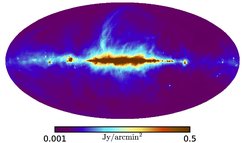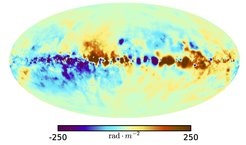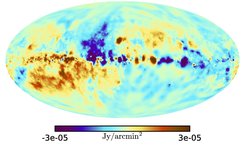Wanted: the rotating radio emission of the Milky Way
The vast space in between the Milky Way stars is not empty; it is filled with gas, dust, magnetic fields, and particles with almost the speed of light - the so-called cosmic radiation. This consists of atomic nuclei, electrons and small amounts of antimatter, especially positrons and antiprotons. Part of the cosmic radiation reaches the earth directly, but it can also be detected indirectly. The ultra-fast electrons and positrons emit radiation, which has already been detected and measured (Fig. 1). So far, however, it is almost impossible to distinguish whether this radio emission originates from electrons or positrons.

Fig. 1: Radio map of the Milky Way. This map shows the amount of electrons with nearly the speed of light times combined with the magnitude of the transverse component of the galactic magnetic field, projected along each line of sight through the Milky Way.
The circularly polarized radiation could tip the scientists off, since electrons and positrons rotate in opposite directions. However, this radiation is less than one thousandth of the galactic radio emission; researchers therefore have been unable to detect it. Moreover, astronomers do not have a clear idea of what patterns to look for in the sky, they do not know what this radiation should look like. This gap has now been filled by Torsten Enßlin and his colleagues. The astrophysicists show that the current information about the magnetic field of the Milky Way is enough to estimate the circular polarization.
Three conditions must be fulfilled for a region in space to radiate circular polarized light. First, there must be an excess of electrons (or positrons) with almost the speed of light, so that the rotation of these particles in the magnetic field will be in a preferred direction. Second, the magnetic field has to be at least partially aligned with the observer so that the direction of rotation is visible in the sky projection. And third, the magnetic field must not be completely in the direction of the line of sight, since the radio waves are mainly emitted transversely to the magnetic field.
Information about both the amount of electrons and positrons with almost the speed of light and the transverse component of the magnetic field is given by the radio map of the Milky Way (Fig. 1). In general, it is assumed that this emission is generated mainly by electrons with only a small contribution by positrons.

Fig. 2: Map of the Faraday effect in the Milky Way. This map shows the line-of-sight component of the galactic magnetic field weighted with the amount of thermal electrons, projected along each line of sight through the Milky Way. Regions where the magnetic field is mainly directed at us are red and regions in which it points away from us are blue.
Information on the line of sight component of the magnetic field comes from measurements of the so-called Faraday effect. Linearly polarized light, radiated from radio-galaxies outside the Milky Way, is being rotated as it traverses the galactic magnetic field. This rotation depends on both the intensity and the orientation of the magnetic field along the line of sight. Radio waves interact with slow thermal electrons in the galactic gas, which perform circular motions in the magnetic fields. The rotation of the linear polarization of the lightwaves is in the opposite direction as the rotation of these electrons. Since the magnitude of the Faraday effect varies with the frequency of the radiation, it can be detected and mapped. In this way, a Faraday map of the sky was produced already in 2012 by Niels Oppermann working with Torsten Enßlin (Fig. 2, MPA Highlight November 2012). This shows the summed up magnetic field component that is aligned with any given line-of-sight.
Thus, all three necessary components are known: the number of electrons at nearly the speed of light, and the strengths of the two magnetic field components involved. The information from observations, however, is always given only as a projection along a line of sight. For an accurate prediction of the circular polarization, further data is needed to describe how these three components are distributed along the lines of sight.

Fig. 3: Map of the intensity and direction of rotation of the circular polarization of the radio emission. Regions in which the polarization is predominantly clockwise are red, and regions with counterclockwise polarization are blue. This prediction was made by combining the intensity maps of galactic radio emission (Figure 1), the Faraday effect (Figure 2), and a rough model of the 3D distribution of galactic electrons. The details of the true circular polarization will differ, but the map should show the correct direction of rotation more often than not if our knowledge of particles at near the speed of light in the Milky Way is more or less correct.
For an estimation of this distribution in the third dimension, Torsten Enßlin used both known and plausible statistical properties of turbulent magnetic fields. Thus, he was able to show that the exact details of the statistics do not have much influence on the results, as long as the magnetic fields do exhibit any improbable structure. The PhD student Sebastian Hutschenreuter then made a prediction of the circular polarization using a coarse model of the distribution of both thermal and highly energetic electrons, as well as the magnetic energy contained in the Milky Way from observed radio and Faraday maps (Figure 3).
The details of the prediction will not be accurate in all details as there were uncertain assumptions. However, the map should indicate the preferred direction of rotation of the actual circular polarization more often than not. This statistical prediction therefore is suitable in searches for the extremely weak circular polarization signal.
The next step will be to look for the predicted small circular polarization pattern in the data of both existing and soon-to-come terrestrial radio telescopes. If astronomers were able to actually detect the "rotating radiation", astronomers could draw important conclusions about the galactic magnetic field and confirm that electrons and not positrons are the source of this radiation in the Milky Way.














